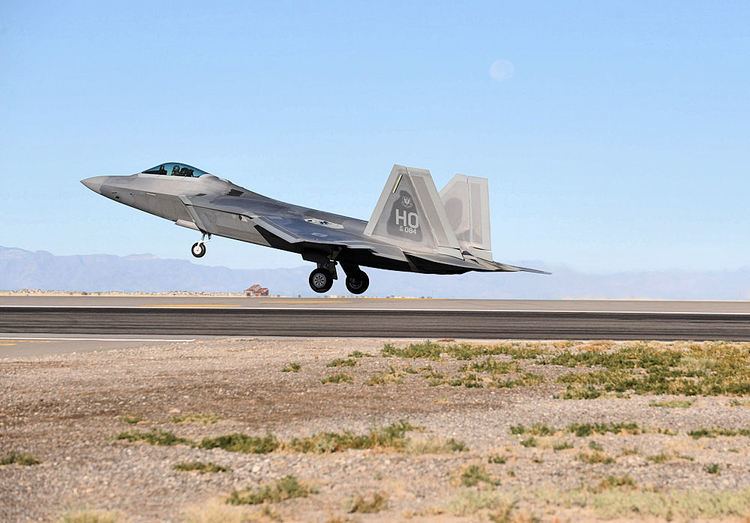Country United States Role Combat Operations | Type Group | |
 | ||
Active 1941–1957; 1991–present Motto(s) Tutor et Ultor - "I Protect and Avenge" | ||
The 49th Operations Group (49 OG) is the operational flying component of the United States Air Force 49th Wing. It is stationed at Holloman Air Force Base, New Mexico, and is a part of Air Combat Command (ACC).
Contents
During World War II, the unit's predecessor unit, the 49th Fighter Group, operated primarily in the Southwest Pacific Theater as part of the Fifth Air Force. The group earned three Distinguished Unit Citations (DUC) for engaging the enemy in frequent and intense aerial combat in numerous campaigns between 1942 and 1945. During the Korean War, the unit initially covered the evacuation of civilian personnel from Kimpo and Suwon in 1950, later flying missions in support of UN ground forces, hitting gun positions, troop concentrations, and other objectives until the 1953 Armistice, remaining in South Korea for a time afterward.
During the modern era, 49th Operations group F-117A Stealth fighters were engaged in combat during Operation Allied Force in 1997, and in Operation Iraqi Freedom in 2003.
Overview
The 49th Operations Group (Tail Code: "HO") supports national security objectives, as directed by the Joint Chiefs of Staff, by utilizing the Air Force's F-22A Raptor Stealth Fighter aircraft and in training U.S. Air Force and allied aircrews in F-22A and T-38 transition, instructor and fighter weapons instructor. The group also conducts training using the MQ-1 Predator and MQ-9 Reaper.
Units of the 49th Operations Group are:
The 7th Fighter Squadron is an operational unit capable of combat operationsHistory
For additional lineage and history, see 49th Fighter WingWorld War II
Media related to 49th Fighter Group at Wikimedia Commons
The 49th Operations Group traces its origins to the formation of the 49th Pursuit Group (Interceptor) at Selfridge Field, Michigan on 20 November 1940. The group trained with Seversky P-35s and consisted of three operational squadrons (7th, 8th, and 9th).
With the advent of World War II, the group moved to Australia and became part of Fifth Air Force in January 1942. It was re-designated as the 49th Fighter Group in May 1942. The unit received Curtiss P-40 Warhawks in Australia and, after training for a short time, provided air defense for the Northern Territory, being awarded a Distinguished Unit Citation for engaging the enemy in frequent and intense aerial combat while operating with limited materiel and facilities for the period March–August 1942.
The group moved to New Guinea in October 1942 to help stall the Japanese drive southward from Buna to Port Moresby. Engaged primarily in air defense of Port Moresby; also escorted bombers and transports, and attacked enemy installations, supply lines, and troop concentrations in support of Allied ground forces.
The 49th participated in the Allied offensive that pushed the Japanese back along the Kokoda Track, took part in the Battle of the Bismarck Sea in March 1943, fought for control of the approaches to Huon Gulf, and supported ground forces during the campaign in which the Allies eventually recovered New Guinea. It covered the landings on Noemfoor and had a part in. the conquest of Biak.
After having used Lockheed P-38 Lightnings, Curtiss P-40 Warhawks and Republic P-47 Thunderbolts, the 49th was equipped completely in September 1944 with P-38's, which were used to fly long-range escort and attack missions to Mindanao, Halmahera, Seram, and Borneo. The unit arrived in the Philippines in October 1944, shortly after the assault landings on Leyte and engaged enemy fighters, attacked shipping in Ormoc Bay, supported ground forces, and covered the Allied invasion of Luzon. For or intensive operations against the Japanese on Leyte, the group was awarded a Distinguished Unit Citation.
Other missions from the Philippines included strikes against industry and transportation on Formosa and against shipping along the China coast. By the war's end, the group's pilots destroyed 668 enemy aircraft (there may be some disagreement here as the 49th group site lists 678 but most sources agree at 668), a record surpassing that of any other fighter group in the Pacific Theater. The group's World War II activities merited two Philippines Republic Presidential Unit Citations, three U.S. Distinguished Unit Citations, and 10 battle honors. Among the unit's 43 aces were Lt. Colonel Boyd D. "Buzz" Wagner, the first World War II ace in the Pacific Theater, and Major Richard I. Bong, whose 40 kills made him America's number one ace (a record that still stands). The 49th soon became endeared to the American people through the nickname, "Fighting 49ers."
Cold War
The 49th moved to Okinawa in August 1945 and to Japan in September. As part of the Army of occupation in Japan, the 49th Fighter Group trained, took part in maneuvers, and flew surveillance patrols, as part of Far East Air Forces. The group was equipped with North American P-51 Mustangs in 1946, with Lockheed F-80 Shooting Stars being added in 1948.
On 10 August 1948, with the adoption of the Hobson Plan, the United States Air Force 49th Fighter Wing was activated, with the 49th Fighter Group being assigned as its combat group. From this point, the history of the 49th Fighter Group is indistinguishable from that of the 49th Fighter Wing. Significant changes to the organization were:
Modern era
On 1 November 1991, the 49th Tactical Fighter Wing adopted the Air Force Objective Organization plan and the 49th Tactical Fighter Group was re-designated as the 49th Operations Group and re-activated. The operational squadrons of the wing came under the control of the Operations Group. The 49th Operations Group was transferred the lineage, honors and history of the 49th Fighter Group.
